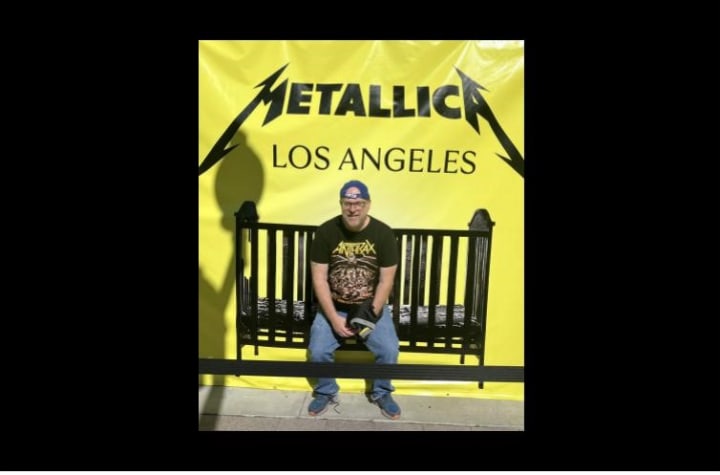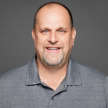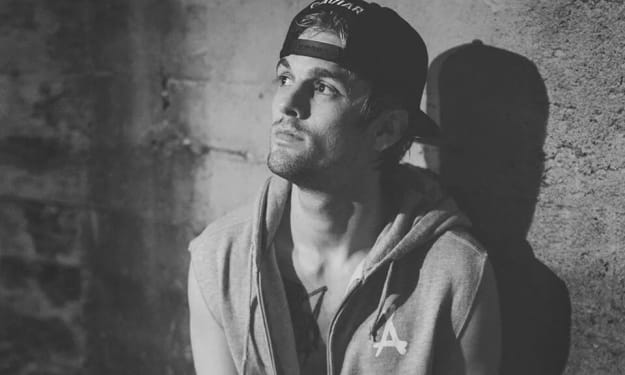Metallica Wins Big At SoFi
Forty-one years into their career, Metallica showed no signs of mellowing during their two-night, record-breaking stop at LA’s SoFi Stadium.
“Angry music for happy people”
– Shirt seen at the Metallica concert
It is often said that the era of Hair Metal was ended by the emergence of grunge emanating out of Seattle. I put the time of death much earlier, years before Nirvana unleashed "Smells like Teen Spirit." I was a witness to Hair Metal's demise on July 26, 1988, when Metallica took the stage for an epic performance at the Los Angeles Memorial Coliseum.
Today Metallica is the biggest metal band in the world and one of the most successful in any genre, but in 1988 they were the second of five bands on the Monsters of Rock concert bill. Still, the stadium was packed as they took the stage at about 3:00 in the afternoon, indicating the reputation they had earned through performances on earlier stops on the tour.
The band was not too far into its first song, Creeping Death, when chaos ensued. As the crowd chanted along to the chorus of "die" during the song’s break, the security line separating the seating area in the bowl from the field was breached and thousands of rowdy fans flooded the field.
As Metallica plowed through their set, the energy level in the crowd continued to crescendo. Then as the band launched into “Whiplash” from their first album, Kill ‘Em All, the power was cut to the sound system resulting in chaos. Minutes before the energy had been dissipated by the music. With the performance interrupted it turned negative. Luckily a DJ from the old metal station, KNAC, was able to take control before the situation devolved into a full-scale riot.
With precision, the band counted back into the song at the exact point where they had been cut off. The energy level of the band or the audience had not been diminished by the unplanned interruption and as the band played the first cords of “Seek and Destroy” the mosh pit began to form. A look of panic swept the faces of the police and security guards as the masses crowding the field began to rotate. A space was cleared and the fans began to crash into each other with wild abandon.
The next band on the bill that day was Dokken. In the shadow of Metallica's triumphant performance, they might as well have been Barry Manilow. Dokken’s brand of polished, commercial metal was dead, replaced by four guys who had substituted makeup and hairspray with raw power.
For a lesser band, the Monsters of Rock performance would have been career-defining. For Metallica, it was just another day at the office. For 41 years they have toured constantly, building their fan base on all seven continents, including Antarctica. Prior to last weekend’s shows at SoFi Stadium, I had seen them eight times. With the exception of Woodstock ‘99, every performance has been amazing.
In my memory, 2003’s Summer Sanatarium 2 tour stands out. The energy of the crowd at the Coliseum that night transformed the night into an almost religious experience. It is always amazing when a crowd of tens of thousands of people sing along to a pop song. There is something awe-inspiring when there is no hook, just raw power, and the lyrics are zooming by at a NASCAR-level clip and the crowd is still in perfect unison. There is a reason why singer James Hetfield has changed the lyrics of "Whiplash" from "We're Metallica" to "You're Metallica!”
Having not seen Metallica live since the 2011 Big 4 show in Indio, I was eager to see how the band has held up and bought my tickets to the two shows at SoFi Stadium. During this “no repeat weekend,” each night would include different opening acts and two unique sets.
As with the two previous shows that I have attended at Sofi, the experience of getting to the stadium was horrifying. Too far removed from the freeway system, the surface streets were clogged almost to the point of gridlock. To make matters worse, streets were randomly closed rendering the directions from my phone useless. After being sent in the wrong direction, we had to backtrack repeatedly. When we finally found our assigned lot we were forced to drive in circles waiting for someone to let us into one lot that was not already full.
Despite leaving my house in the Valley at 2:30 for a 6:00 show, I missed the first opening act, Wolfgang Van Halen's Mammoth. He sounded good from the parking lot’s walkway.
We settled into our seats in time to see the band calling itself "Pantera" take the stage with the two surviving members joined by Zakk Wylde on guitar and Anthrax's Charlie Benante on drums, the band expertly riled up the crowd. Singer Phil Anselmo’s appreciation for the opportunity was evident throughout the performance.
Metallica entered the stage area to the well-chosen AC/DC song "It's a Long Way to the Top (If You Wanna Rock 'N' Roll)" This was followed by the band's customary introductory music, “Ecstasy of Gold.’ Then as they did 35 years ago they began the show with “Creeping Death.”
The band seemed to feed off the direct interaction with the crowd which was encouraged by the unique setup of the stage which was a large circle placed at the 50-yard line. The space within the stage was designated the “snake pit" and filled with fans.
Much to the appreciation of this drummer, Lars Ulrich had four different drum sets stored under the stage, each one making an appearance at different parts of the night. These sets also rotated between songs to give fans different views as the show progressed.
Since the stage was in the center, the lighting and sound systems could not be hung from a view-blocking scaffolding. Instead, individual towers supported lighting and giant video screens. These also supported the sound and a camera that flew over the band. The result was a show that encompassed the entire stadium.
While pyrotechnics were used to punctuate aspects of the performance, they were understated, allowing the focus to remain on the music. The years of touring experience were evident as the band plowed through their set and the crowd responded with enthusiasm. Highlights of the night included "Seek and Destroy," "Master of Puppets," and "Fuel." While many songs were left off the first night’s setlist, making them available for Sunday’s show during the “no repeat weekend.”
Instead of the cliched encore, the band simply hovered on stage. Guitarist Kirk Hammett and Bassist Robert Trujillo handed out bucketloads of guitar picks and Lars shook a lot of hands. All of them took turns at the mike to give thanks to the crowd.
I left the stadium impressed by the performance and eager for more. Unfortunately, the exit out of the parking lot killed some of the music-induced buzz as the departure was almost as bad as the arrival experience.
The biggest difference between Friday’s Metallica and the band I first saw three and a half decades ago is the transformation of singer James Hetfield. Once a man whose persona was as angry as his music, singer James Hetfield no longer growls from the stage between songs. Instead, he shows appreciation for the audience who has made his dreams come true. He makes frequent references to the “Metallica Family."
While Metallica has been based out of the Bay Area for most of their career, the band was formed in Los Angeles, making the shows at SoFi a sort of homecoming. Both Hetfield and Ulrich took time at the Friday show to reflect on what the concert meant to them.

Learning our lessons from Friday, we entered the parking lot hours early on Sunday. This gave us time to visit the pop-up store located a mile from the stadium. It was weird to get to our seats and already know our neighbors, but it added to a sense of community.
The first opener on Sunday was Ice Nine Kills. This band takes their inspiration from horror films and their stage show followed this theme with multiple murders being dramatized on stage. It was campy but interesting.
I had been looking forward to seeing Five Finger Death Punch as they are one of my sister's favorite bands. Unfortunately, their singer was sick and could not perform. Having substitutes on stage made it feel more like a jam session than a polished performance. I also thought it was bad form for them to not make any kind of an announcement before starting the show.
When Metallica took the Stage for the second night's performance, there was an added spark that was not present on Friday. This was true for both the band and the audience. "Whiplash" is a song from Metallica's first album that has no commercial appeal. On paper, it seemed like a strange way to start the set, but the crowd went wild. Multiple mosh pits sprung up across the floor, including one in the middle of the snake pit.
These pits grew as the night went on. Even new songs played from the band's latest effort, 72 Seasons, did not diminish the enthusiasm. The crowd even Moshed through the ballad "Sanatarium! The only break occurred during the instrumental "The Call of Ktulu."
The night flew by and before I knew it, the band's most successful songs, "One" and "Enter Sandman" signaled the climax of the night. Even after playing for four hours over two nights songs like "Blackened," "Battery" and the Cover of Queen's “Stone Cold Crazy" had been left out, showing just how strong the band's catalog is.
Incidentally, a year prior I had spent a night in the same stadium watching a disappointing Mötley Crüe performance. While that hair-metal band phoned in their performance and fumbled badly, Metallica had taken no prisoners.
Once outsiders whose powerful music was dismissed by the mainstream, Metallica fought for success on their own terms and found acceptance for their music made for outcasts. Fueled by a hard-core work ethic, they have been so successful at moving the goalposts of what is considered commercially acceptable that their inclusion of the 1996 Lollapalooza tour was criticized as moving the festival in a direction that was "too corporate."
Forty-one years into their careers, Metallica is still at the top of their game.

____________________________
Carl Petersen is a parent advocate for public education, particularly for students with special education needs, who serves as the Education Chair for the Northridge East Neighborhood Council. As a Green Party candidate in LAUSD’s District 2 School Board race, he was endorsed by Network for Public Education (NPE) Action. Dr. Diane Ravitch has called him “a valiant fighter for public schools in Los Angeles.” For links to his blogs, please visit www.ChangeTheLAUSD.com. Opinions are his own.
About the Creator
Carl J. Petersen
Carl Petersen is a parent advocate for students with SpEd needs and public education. As a Green Party candidate in LAUSD’s District 2 School Board race, he was endorsed by Network for Public Education (NPE) Action. Opinions are his own.






Comments
There are no comments for this story
Be the first to respond and start the conversation.